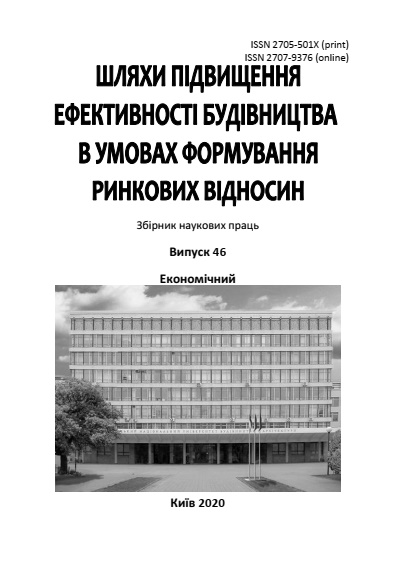Investment risk management and energy efficiency, considering capital and operating expenditure in industrial development
DOI:
https://doi.org/10.32347/2707-501x.2020.46.56-64Keywords:
investment project, capital expenditure, operational expenditure, project risk management, energy efficiency, energy saving, industrial developmentAbstract
The article clarified the impact of investment risk management on energy efficiency as a significant factor affecting the cost of an industrial development project. The effective implementation of any new construction or reconstruction project is inextricably linked with financial risk management, that allows take into account all possible expenditures that are not only once spent on its implementation (capital expenditures), but also operational expenditures that will be incurred when it is transferred into operation. A very important problem is the assessment of the real cost of the project, taking into account the operational expenditures during the life cycle of the building, as well as the optimization of both the capital expenditures (CAPEX) of the development company and the operational expenditures (OPEX). The implementation of development projects can be divided into three main stages: pre-investment, investment and operational. The sources of possible successes or failures in the implementation of entrepreneurial development projects are questions that are usually laid down in the early stages of organizing the construction of real estate objects. Therefore, the most important feature in the construction projects management in the field of industrial development is taking into account the dominant influence exerted on the efficiency of the first, pre-investment, phase. As a result, it allows to obtain significant cost-savings in the total cost of the project. All this requires to analyze various design solutions due to the Investor's desire to optimize capital expenditures, which will significantly reduce the costs of some project design solutions. Considering the above, a calculation algorithm is proposed to determine the total cost of the building's life cycle. During the research, an economically and energy-efficient model of using the enclosing structure for an industrial building was determined, which allows obtaining significant costs-savings, taking into account the operational expenditures during the life cycle of the building.
References
Закон України «Про енергетичну ефективність будівель». [Електронний ресурс] // Відомості Верховної Ради України (ВВР). – 2017. – № 33. – с. 5. – Режим доступу: https://zakon.rada.gov.ua/laws/show/2118-19#Text.
ДБН В.2.6-31.2016. Теплова ізоляція будівель. – Чинний від 2017-04-01. – Київ: Мінрегіон України, 2016. – 30 с.
Брикало Ю. Параметричний метод нормування в будівництві з 19.10.2019. [Електронний ресурс]. – Режим доступу: https://dreamdim.ua/ru/parametrychnyj-metod-normuvannya-v-budivnytstvi/
Мінрегіон пропонує будувати житло з класом енергоефективності не нижче «С». [Електронний ресурс]. – Режим доступу: https://ecolog-ua.com/news/minregion-proponuye-buduvaty-zhytlo-z-klasom-energoefektyvnosti-ne-nyzhche-s (Дата звернення 28.08.2020)
Donald Towey. Construction quantity surveying: a practical guide for the contractor's QS, 2nd Edition. Wiley-Blackwell, 2017. 337 p.
Ізмайлова К.В. Регресивна модель впливу проектних рішень на енергоефективність будівлі [Текст] / К.В. Ізмайлова // Шляхи підвищення ефективності будівництва в умовах формування ринкових відносин. – 2020. – № 44. – С. 108–115.
Барзилович Д., Лагунова І., Бардасова І., Буравченко С., Нечепорук А., Медведчук О., Марушева О., Колесник В. Зелена книга. Системний перегляд ефективності державного регулювання. Параметричне нормування у будівництві. [Електронний ресурс]. – Київ: 2020. – 91 c. – Режим доступу: https://cdn.regulation.gov.ua/c6/ba/18/d2/regulation.gov.ua_Parametrychne-normuvannia-Construction.pdf?fbclid=IwAR0KpoR5rn1e8xlOLnyYbk_N6miHJHaZlYk2OPwXrTVkzPueFF7IWg74vD0
Малахов В. Управление инвестиционными рисками: Технология "Инвестиционного Веера"! [Електронний ресурс]. – Режим доступу: https://ardexpert.ru/article/18618
Baruch Lev, Suresh Radhakrishnan, Jamie Yixing Tong Risk Management for Tangible and Intangible Investments: The Relationship between R&D and Capital Expenditures and Risk Components. [Електронний ресурс]. – Режим доступу: http://people.stern.nyu.edu/blev/intangibles/Risk%20Management%20for%20Tangible%20and%20Intangible%20Investments.pdf
Ізмайлова К.В. Урахування класу енергоефективності житлової будівлі у параметричному ціноутворенні [Текст] / К.В. Ізмайлова // Шляхи підвищення ефективності будівництва в умовах формування ринкових відносин. – 2019. – № 42. – С. 19 –25.
Прядко М.В., Руднєва І.М., Прядко Ю.М. Обстеження та підсилення будівельних конструкцій промислових будівель: Навчальний посібник. – Київ: КНУБА, 2018. – 332 с.
Руднєва І., Прядко Ю., Прядко М. Аналіз причин обвалення покрівель виробничих будівель. Збірник наукових праць "Будівельні конструкції. Теорія і практика". № 6 (2020), c. 85-93. https://doi.org/10.32347/2522-4182.6.2020.85-93
Селина В.П. Возможность использования теории реальных опционов в управлении рисками девелоперских проектов в строительстве // РИСК: Ресурсы, информация, снабжение, конкуренция. – 2011. – № 2. – c. 137-141.
Вирцев М.Ю., Сайфуллина Ф.М. Управление инвестиционными рисками девелоперского проекта с использованием метода реальных опционов // Российское предпринимательство. – 2017. – Том 18. – № 23. – С. 3877-3886. doi: 10.18334/rp.18.23.38611
Downloads
Published
How to Cite
Issue
Section
License

This work is licensed under a Creative Commons Attribution 4.0 International License.
Authors who publish with this journal agree to the following terms:
- Authors retain copyright and grant the journal right of first publication with the work simultaneously licensed under a Creative Commons Attribution License that allows others to share the work with an acknowledgement of the work's authorship and initial publication in this journal.
- Authors are able to enter into separate, additional contractual arrangements for the non-exclusive distribution of the journal's published version of the work (e.g., post it to an institutional repository or publish it in a book), with an acknowledgement of its initial publication in this journal.
- Authors are permitted and encouraged to post their work online (e.g., in institutional repositories or on their website) prior to and during the submission process, as it can lead to productive exchanges, as well as earlier and greater citation of published work (See The Effect of Open Access).

